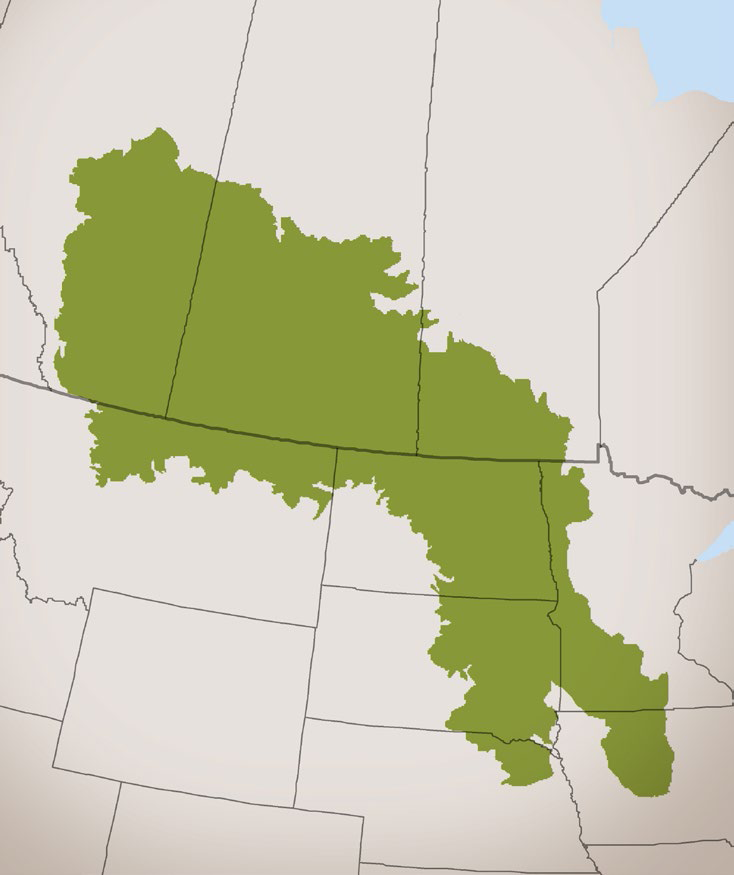Stewart & Kantrud Classification System
The formerly glaciated prairie region includes parts of the northern prairies in the Central Lowland and Great Plains, which were covered with glacial drift deposits during the past Ice Age. The regions is characterized by numerous undrained depressions throughout southern Alberta, southern Saskatchewan, extreme southwestern Manitoba, extreme northeastern Montana, northern and east-central North Dakota, eastern South Dakota, and small portions of western Minnesota and northwestern Iowa.
Wetland vegetation in prairie ponds and lakes can be grouped into zones each characterized by a different community structure or life form and a distinct assemblage of plant species. These vegetation zones are designated as follows:
Wetland-low-prairie zone;
Wet-meadow zone;
Shallow-marsh zone;
Deep-marsh zone;
Permanent-open-water zone;
Intermittent-alkali zone; and
Fen (alkaline bog) zone.
In each zone, characteristic plants may be found as a general mixture or may be represented by one or more distinct associations, each composed of one or more species. These zones are closely related to differences in water permanence, modified by permeability of bottom soils and influence of ground water. Certain wetlands contain only one zone, while others contain two, three, or more zones. In wetlands with two or more zones, one zone usually occupies the central, deeper part of the pond basin, while the others occur as concentric peripheral bands. The presence or absence and the distributional pattern of the zones are the primary factors used in distinguishing the seven major classes of wetlands as detailed below. The wetland class is determined by the vegetation zone occupying the central 5% or more of the total wetland area.
Class I - Ephemeral Wetlands typically have free surface water for only a short period of time after snowmelt or storm events in early spring. Because of the porous condition of the soils, the rate of water seepage from ephemeral wetlands is very rapid after thawing of the underlying frost seal. They may be periodically covered by standing or slow moving water. Water is retained long enough to establish some wetland or aquatic processes. They are typically dominated by Kentucky bluegrass, goldenrod and other wetland or low prairie species.
Class II - Temporary Wetlands are periodically covered by standing or slow moving water. They typically have open water for only a few weeks after snowmelt or several days after heavy storm events. Water seepage is fairly rapid, but surface water usually lingers for a few weeks after spring snowmelt and for several days after heavy rainstorms at other times of the year. Water is retained long enough to establish wetland or aquatic processes. They are dominated by wet meadow vegetation such as fine-stemmed grasses, sedges and associated forbs.
Class III - Seasonal Ponds and Lakes are characterized by shallow marsh vegetation, which generally occurs in the deepest zone (usually dry by midsummer). These wetlands are typically dominated by emergent wetland grasses, sedges and rushes.
Class IV - Semi-permanent Ponds and Lakes are characterized by marsh vegetation, which dominates the central zone of the wetland, as well as coarse emergent plants or submerged aquatics, including cattails, bulrushes and pondweeds. These wetlands frequently maintain surface water throughout the growing season, i.e., from May to September.
Class V - Permanent Ponds and Lakes have permanent open water in central zone that is generally devoid of vegetation. Submerged plants may be present in the deepest zone, while emergent plants are found along the edges. Plants commonly present in these wetlands include cattails, red swampfire and spiral ditchgrass.
Class VI - Alkali Ponds and Lakes are wetlands where deep water is typically not permanently present. Alkali wetlands are characterized by a pH above 7 and a high concentration of salts. The dominant plants are generally salt tolerant and include red swampfire and spiral ditchgrass. These wetlands are especially attractive for shore birds.
Class VII - Fen Ponds are wetlands in which fen vegetation dominates the deepest portion of the wetland area. This wetland type often has wet meadow and low prairie vegetation present on the periphery. The soils are normally saturated by alkaline groundwater seepage. Fen ponds often have quaking or floating mats of emergent vegetation, which includes sedges, grasses and other herbaceous plants.
A more detailed description of the seven wetland classes can be found in:










